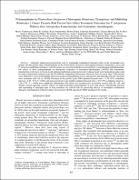| dc.contributor.author | Venkatesan, M | |
| dc.contributor.author | Gadalla, N. B. | |
| dc.contributor.author | Stepniewska, K | |
| dc.contributor.author | Kironde, Fred | |
| dc.date.accessioned | 2017-05-30T10:12:07Z | |
| dc.date.available | 2017-05-30T10:12:07Z | |
| dc.date.issued | 2014 | |
| dc.identifier.citation | Venkatesan, M...et al (2014) Polymorphisms in Plasmodium falciparum Chloroquine Resistance Transporter and Multidrug Resistance 1 Genes: Parasite Risk Factors that Affect Treatment Outcomes for P. falciparum Malaria after Artemether-Lumefantrine and Artesunate-Amodiaquine. Research Article. | en_US |
| dc.identifier.uri | http://hdl.handle.net/20.500.12309/186 | |
| dc.description.abstract | Adequate clinical and parasitologic cure by artemisinin combination therapies relies on the artemisinin component
and the partner drug. Polymorphisms in the Plasmodium falciparum chloroquine resistance transporter ( pfcrt) and
P. falciparummultidrug resistance1(pfmdr1) genes are associated with decreased sensitivity to amodiaquine and lumefantrine,
but effects of these polymorphisms on therapeutic responses to artesunate-amodiaquine (ASAQ) and artemetherlumefantrine
(AL) have not been clearly defined. Individual patient data from 31 clinical trials were harmonized and pooled
by using standardized methods from the WorldWide Antimalarial Resistance Network. Data for more than 7,000 patients
were analyzed to assess relationships between parasite polymorphisms in pfcrt and pfmdr1 and clinically relevant outcomes
after treatment with AL or ASAQ. Presence of the pfmdr1 gene N86 (adjusted hazards ratio = 4.74, 95% confidence
interval = 2.29 – 9.78, P < 0.001) and increased pfmdr1 copy number (adjusted hazards ratio = 6.52, 95% confidence interval =
2.36–17.97, P < 0.001) were significant independent risk factors for recrudescence in patients treated with AL. AL and
ASAQ exerted opposing selective effects on single-nucleotide polymorphisms in pfcrt and pfmdr1. Monitoring selection
and responding to emerging signs of drug resistance are critical tools for preserving efficacy of artemisinin combination
therapies; determination of the prevalence of at least pfcrt K76T and pfmdr1 N86Y should now be routine. | en_US |
| dc.language.iso | en | en_US |
| dc.subject | Artemether-Lumefantrine | en_US |
| dc.subject | Artesunate-Amodiaquine | en_US |
| dc.subject | Polymorphism | en_US |
| dc.subject | Genes | en_US |
| dc.subject | P. falciparum Malaria | en_US |
| dc.subject | Malaria | en_US |
| dc.subject | Parasite | en_US |
| dc.subject | Chloroquine | en_US |
| dc.title | Polymorphisms in Plasmodium falciparum Chloroquine Resistance Transporter and Multidrug Resistance 1 Genes: Parasite Risk Factors that Affect Treatment Outcomes for P. falciparum Malaria after Artemether-Lumefantrine and Artesunate-Amodiaquine | en_US |
| dc.type | Article | en_US |

